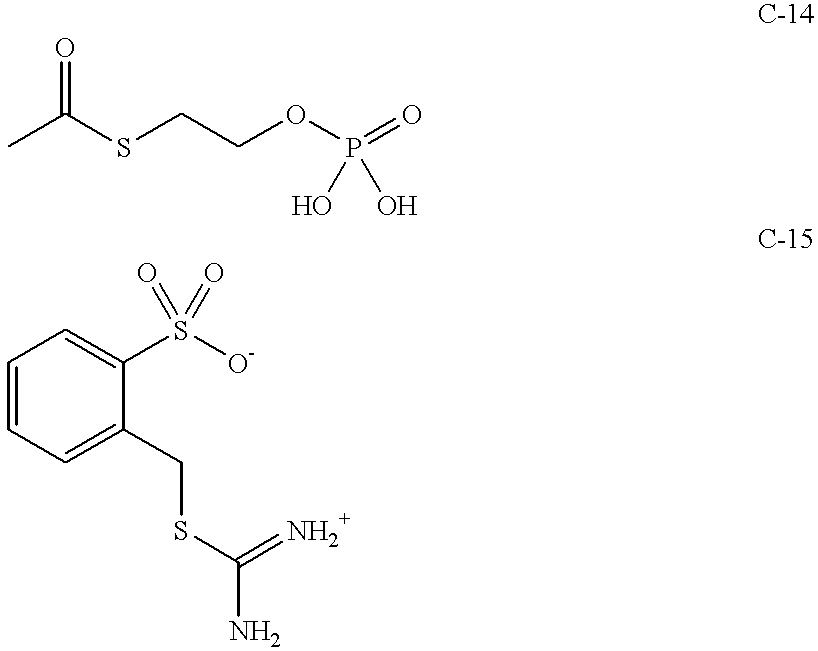Processing method of light-sensitive silver halide photographic materials showing less tendency to sludge formation
a technology of silver halide and processing method, which is applied in the direction of photosensitive materials, silver-salt material processes, instruments, etc., can solve the problems of forming ever lasting sludge, rollers and on the racks, and the addition of fungicide-treated water as a solution in u.s. pat. no. 4,839,273 is not always desired, so as to reduce the amount of sludge formation and eliminate the problem
- Summary
- Abstract
- Description
- Claims
- Application Information
AI Technical Summary
Benefits of technology
Problems solved by technology
Method used
Image
Examples
example 1
In order to determine the complexing properties of compounds having ability to form silver complexes as those suitable for use in the method of the present invention following experiment was performed, wherein as a useful substance the silver complexing compound according to the formula (C-2) was examined. ##STR6##
The silver complexing ability was measured as follows
1. From compound CC-2 50 mg was added to 200 ml of the test developer the composition of which is given hereinafter in Table 3.
2. Under constant vigorous stirring making use therefore from a magnetic stirrer, 74 ml of a 0.0005 mole / l of a silver nitrate solution was slowly added to the developer solution over a period of 30 minutes, giving a total silver amount of 15 mg / l.
3. After addition of this silver nitrate solution, the solution was left unstirred and the silver content in the supernatant fluid was measured (by the atomic absorption spectrophotometric technique, also called "AAS") as a function of time.
In the Table...
example 2
Complexing agents suitable for use in the developer composition used in the processing method according to the present invention have been tested, following the procedure described above. The results are listed in Table 5 hereinafter.
Comparative examples without solubilizing group the formulae of which have been represented above do not show a significant improvement with respect to the "complex stability ratio" if compared with a reference sample without complexing agents (- - - -).
Introduction of suitable stabilizing groups clearly improves the stability of silver ions present in the developer suitable for use in the processing method of the present invention.
example 3
An experiment similar to the experiment in Example 1 was performed. In this case however amounts of silver and complexing ragent were varied. The silver concentration in the silver nitrate solution was varied from 0.0005 mole / l up to 0.0040 mole / l, resulting in a total amount of silver added from 15 to 120 mg / l. The concentration of complexing agents was varying from 0 to 2000 mg / liter. As preferred complexing agent use was always made from compound C-1. ##STR9##
The Table 6 lists the concentration of the silver nitrate solution, the total amount of silver added (in mg / l), the amount of complexing agent C-1 added (in mg / l) and the molar ratio of complexing agent to silver. In the said Table 6 also the amount of silver measured in the supernatant fluid after 3 weeks and the relative procentual amount of silver in the solution after 3 weeks has been summarized. When the relative amount is close to 0, all silver has been precipitated. When the relative amount is close to 100%, this mean...
PUM
| Property | Measurement | Unit |
|---|---|---|
| pKa | aaaaa | aaaaa |
| speed | aaaaa | aaaaa |
| width | aaaaa | aaaaa |
Abstract
Description
Claims
Application Information
 Login to View More
Login to View More - R&D
- Intellectual Property
- Life Sciences
- Materials
- Tech Scout
- Unparalleled Data Quality
- Higher Quality Content
- 60% Fewer Hallucinations
Browse by: Latest US Patents, China's latest patents, Technical Efficacy Thesaurus, Application Domain, Technology Topic, Popular Technical Reports.
© 2025 PatSnap. All rights reserved.Legal|Privacy policy|Modern Slavery Act Transparency Statement|Sitemap|About US| Contact US: help@patsnap.com



